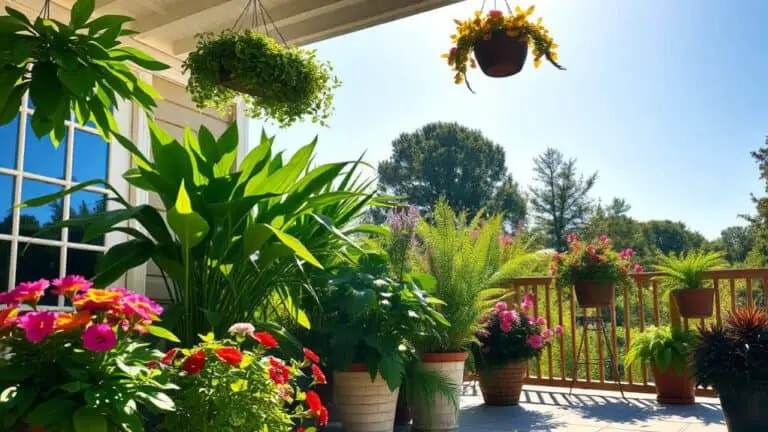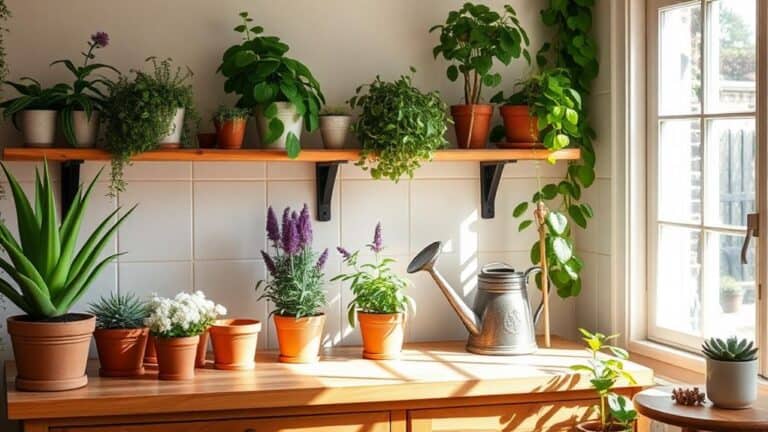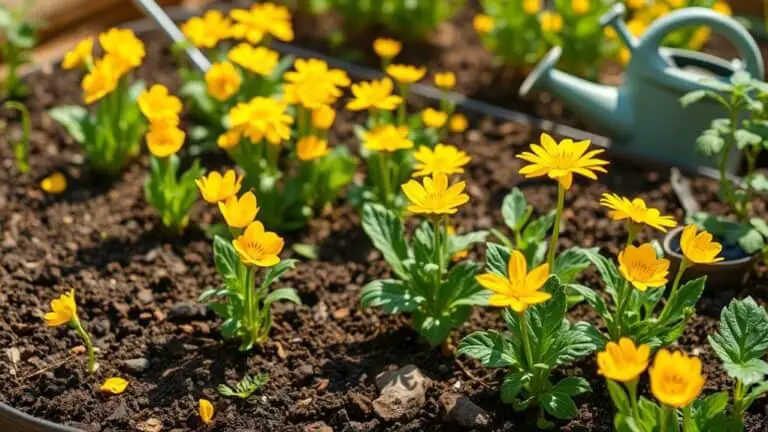How To Take Control Of Pests During Flowering
When it comes to taking control of pests during flowering, I've found that the key lies in a mix of vigilance and smart interventions. Regular monitoring helps spot issues early, but knowing which organic methods to use, like neem oil or introducing ladybugs, can make a huge difference. But what happens when these methods aren't enough? Sometimes, you need to reflect on chemical solutions, though they require careful handling. Let's explore the specifics of each approach and how to balance them effectively for a thriving garden.
Identifying Common Pests
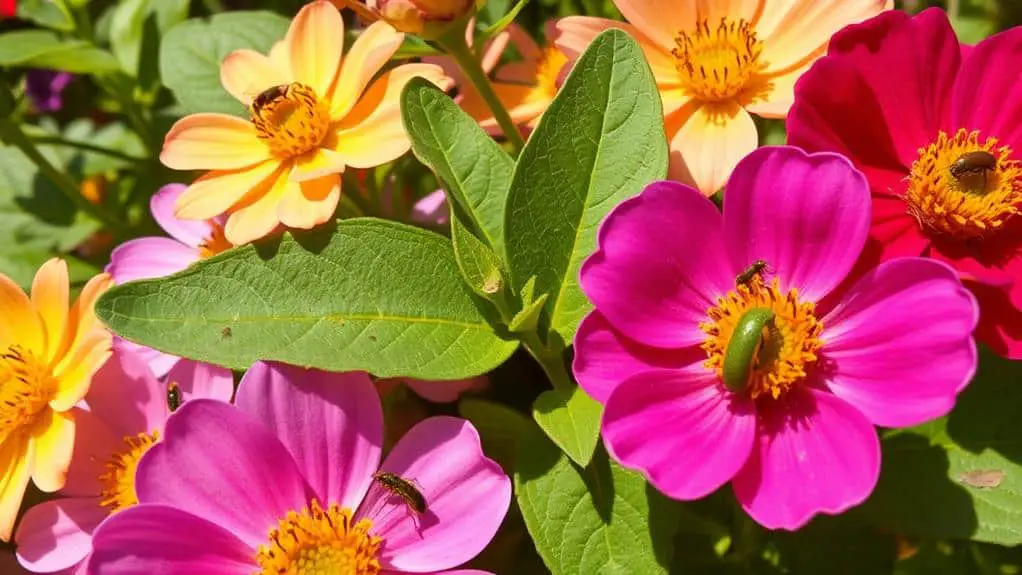
During the flowering stage, pests can become a significant issue if not identified early.
Let's talk about identifying common pests that might target your cannabis plants.
Spider mites are notorious cannabis pests; they leave fine webs and cause yellowing or mottled leaves.
Whiteflies feed on plant sap, weakening your plants.
Aphids are small, green insects that distort growth by sucking sap from young leaves and buds.
Thrips create shiny silver or bronze spots on leaves, leading to brittle foliage.
Fungus gnats thrive in overwatered soil, with larvae damaging roots.
Finally, broad mites, though tiny, twist new growth and lay eggs within plant tissues, stunting development.
Knowing these signs helps you protect your plants.
Early Pest Detection
Early pest detection is absolutely essential in maintaining healthy cannabis plants during the flowering stage.
By monitoring plants regularly, you can catch issues before they spiral out of control.
Here's what I do:
- Inspect Leaves: Look for yellowing leaves or webbing, which are early signs of pests.
- Use a Jeweler's Loop: This helps me spot tiny pests like spider mites and aphids up close.
- Set Up Sticky Traps: These traps catch flying pests like whiteflies and fungus gnats, preventing major damage.
- Maintain Cleanliness: Keeping the grow area clean and removing infested plant material helps me stay ahead.
Early pest detection, combined with monitoring plants, makes a big difference in keeping pests at bay.
Organic Pest Control
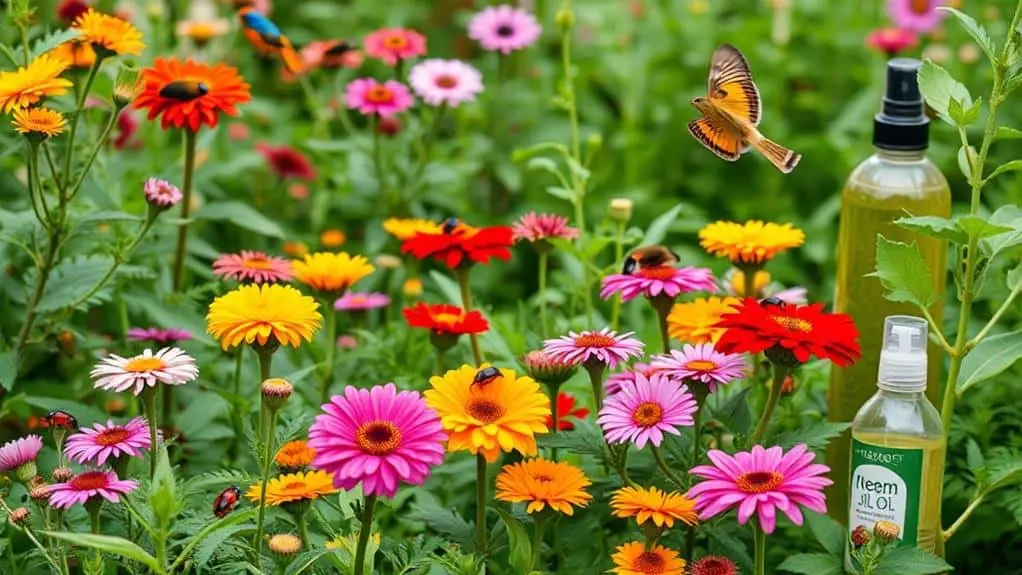
When it comes to managing pests organically during the flowering stage, I've found that natural methods are both effective and safe for the plants. One of my go-to organic methods is using neem oil. It's great against spider mites but remember to dilute it properly.
Homemade foliar sprays with garlic powder and cayenne pepper can also deter pests without harming your plants. Introducing beneficial insects like ladybugs and lacewings is another smart move—they love munching on aphids and other pests.
Always keep an eye on your plants and apply these organic solutions during cooler parts of the day. Finally, maintain soil health with organic matter and compost to make your plants more resilient.
These steps will help you keep pests at bay naturally.
Chemical Control Methods
When it comes to using chemical control methods during flowering, choosing the right insecticides and timing their application is key.
Spinosad can be effective, but be mindful of residue that might affect your final product.
Always consider safety and health precautions, especially with stronger insecticides like Avid and Forbid, which should be used sparingly and never on crops meant for consumption or smoking.
Effective Insecticide Choices
Controlling pests during the flowering stage of plant growth can be a delicate balancing act, and choosing the right insecticide is essential.
I've found a few effective options that can help manage those pesky mites and other pests.
- Spinosad: This organic choice is effective against many pests, but use it carefully since residues can linger.
- Avid: A strong chemical insecticide, great for severe infestations, but be cautious with edible crops.
- Forbid: Similar to Avid, it's effective but should be rotated with other products to avoid resistance.
- Mighty Wash: Use this as a drenching treatment before lights out to control pests without too much light exposure.
Application Timing Strategies
Timing your pest control applications can make all the difference in managing infestations effectively during the flowering stage.
Apply chemical methods like Capt. Jack's Deadbug or Spinosad in the late evening or just before lights out. This avoids light exposure that could weaken the treatment.
For heavy infestations, increase the concentration to 40ml/gallon, ensuring thorough coverage on both sides of the leaves.
Always turn off fans during application to prevent drift and keep the pesticide on the plants.
Monitor the residual effects, as Spinosad can last over a month. Stick to the recommended intervals, reapplying every 3-5 days if needed.
These strategies help you manage pests while protecting your flowering phase.
Safety and Health Precautions
Securing safety and health during the application of chemical control methods is paramount.
When using chemicals like spinosad, timing and technique are essential to minimize exposure and maintain plant health. Here's a simple guide to help you manage this effectively:
- Read and follow product labels: Always adhere to instructions to avoid harming your plants.
- Apply chemicals before lights turn off: This prevents light from degrading the product and stressing your plants.
- Turn off fans and guarantee good ventilation: This reduces chemical drift and lowers inhalation risks.
- Be mindful of residue: Spinosad can leave residues for over a month, so plan applications to avoid contamination during flowering.
Following these steps will help secure both your safety and the well-being of your plants.
Application Techniques
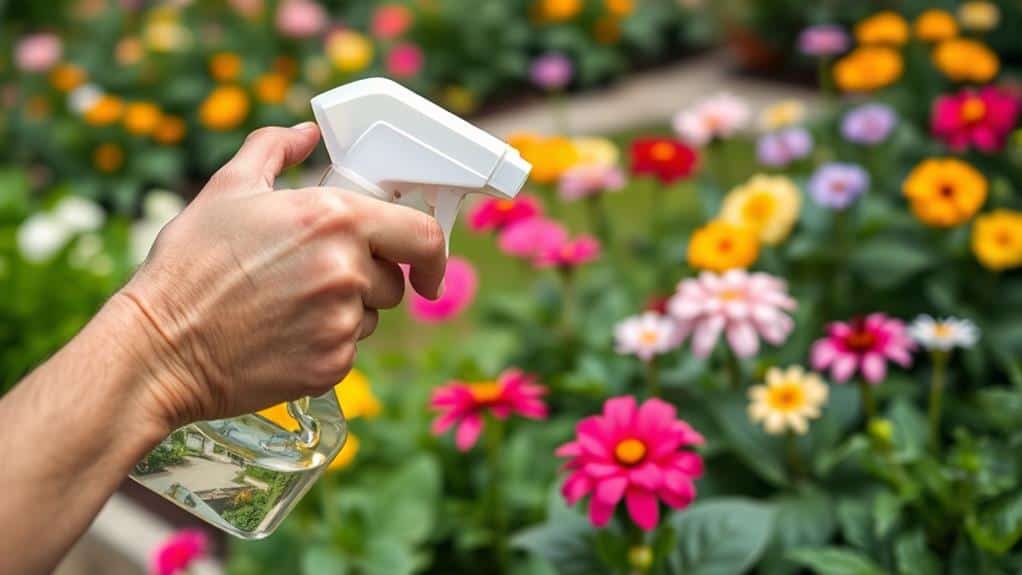
Applying pest control solutions during the flowering stage requires precision and attention to detail.
In cannabis pest control, effective application techniques make all the difference. Always apply solutions during cooler parts of the day, like early morning or late evening, to prevent leaf damage and improve absorption.
Make certain to cover both the tops and undersides of leaves, as pests often hide in these areas. Turn off fans and ventilation systems to avoid drift and guarantee the pesticide stays on the plant surfaces.
For heavy infestations, increase the concentration of your solution as recommended and reapply every few days.
Safety and Health Concerns
When it comes to pest control during the flowering stage, safety and health concerns must be front and center.
It's essential to make careful choices to keep your plants and yourself safe. Here are some key points to take into account:
- Spinosad: While effective, it has potential carcinogenic properties. Be cautious with its residue, especially indoors.
- Neem Oil: It's a great organic option, but always dilute it correctly to avoid harming your plants.
- Smoking Residues: Pesticides can become more toxic when smoked, posing health risks. Avoid using harmful chemicals on cannabis.
- Organic Methods: Choose organic pest control to minimize health risks and avoid harmful residues.
Soil Health and Quality

Let's talk about soil health and quality because it's essential for keeping pests at bay during flowering.
By balancing nutrients and adding organic matter like compost, we can make our plants stronger and more resilient.
Plus, boosting microbial activity with things like compost tea can really help our plants fend off pests naturally.
Nutrient Balance Importance
Maintaining a balanced nutrient profile in your soil is vital for cultivating healthy cannabis plants that can naturally fend off pests during the flowering stage.
Healthy soil, rich in organic matter, boosts nutrient availability and enhances plant immunity. Regular soil testing is important to identify nutrient deficiencies or imbalances. This way, you can make timely amendments to keep your plants robust and resilient.
Here are some tips to maintain nutrient balance:
- Use amendments like neem seed meal and crab meal – These improve soil health and act as natural pest deterrents.
- Apply compost tea – It enriches soil and promotes beneficial microbial activity.
- Maintain proper pH levels – This guarantees ideal nutrient uptake.
- Test soil regularly – Identify and correct any imbalances early.
Organic Matter Benefits
Incorporating organic matter into your soil greatly enhances its health and quality, providing numerous benefits to your cannabis plants. By adding compost and worm castings, you'll improve nutrient availability and boost your plants' immunity against pests and diseases.
Using organic and safe amendments like neem seed meal and crab meal not only enriches soil health but also deters pests naturally. Healthier soil structure means better water retention and drainage, reducing conditions that favor pest infestations.
Organic matter supports beneficial soil organisms, like nematodes, which target soil-dwelling pests. Maintaining diverse organic materials fosters a balanced ecosystem, helping your plant tissue grow strong and resilient. This reduces the need for chemical pest control and promotes a thriving garden.
Microbial Activity Boost
A key strategy to control pests during the flowering stage is boosting microbial activity in the soil.
Healthy soil is the foundation of resilient plants. By enhancing microbial activity, you're improving nutrient availability and plant immunity.
Here's how to do it:
- Incorporate Organic Matter and Compost: This improves soil structure and microbial diversity.
- Regular Soil Testing: Identifies nutrient deficiencies, allowing for targeted amendments.
- Add Neem Seed Meal and Crab Meal: These amendments enrich the soil and introduce natural pest deterrents.
- Use Compost Tea: As a soil drench, it introduces beneficial microorganisms.
Beneficial Insects
When it comes to controlling pests during the flowering phase, beneficial insects can often be a grower's best ally.
Ladybugs, for instance, are incredible at tackling common pests like aphids, consuming up to 5,000 in their lifetime.
Lacewings are another great option, with their larvae devouring aphids and thrips.
If you're dealing with spider mites, introducing predatory mites like Phytoseiulus persimilis can be a game-changer since they specifically target these pests.
By encouraging a balance of beneficial insects in your garden, you can cut down on the need for chemical pesticides, promoting a healthier environment.
For best results, try releasing these helpful insects in the evening to increase their chances of staying in your garden.
Preventive Measures
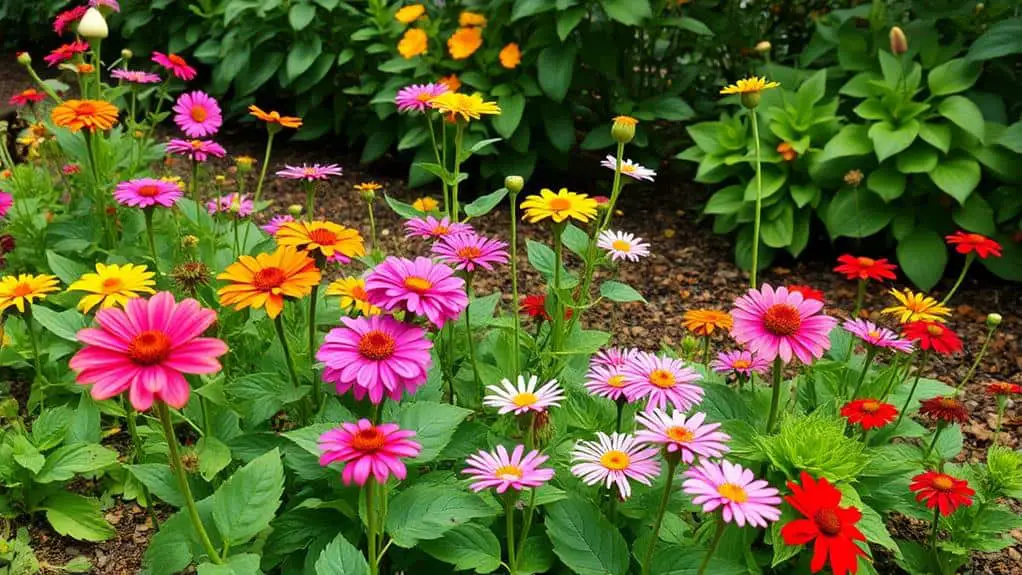
To keep pests at bay during flowering, start by regularly checking your plants for any early signs of trouble.
Keep your grow area clean and make sure to control the environment by using air filters and proper ventilation.
Also, don't forget to quarantine new plants and adjust watering habits to prevent creating conditions that pests love.
Regular Monitoring Practices
Even though it might seem tedious, regularly checking your plants for pests is essential during the flowering stage. Monitoring your plants allows you to spot signs of trouble early, like webbing or discoloration, so you can act fast.
Here's a simple routine to follow:
- Inspect all leaves: Check both the upper and underside of each leaf, as pests like spider mites and aphids often hide there.
- Use sticky traps: Place these around your grow area to catch flying pests and monitor their population.
- Maintain cleanliness: Remove debris and dead plant material to reduce pest habitats.
- Quarantine new plants: Keep new additions separate for at least a week to prevent introducing pests to your main grow area.
Environmental Control Techniques
A few key environmental control techniques can make a significant difference in keeping pests at bay during the flowering stage.
First, maintaining cleanliness in your grow space by removing debris and dirt can deter pests. Implementing high-quality air filtration systems, like CleanLeaf, improves air circulation, making the environment less attractive to pests.
Regular monitoring of plants, including checking the undersides of leaves, is essential for early detection. Quarantining new plants for at least a week prevents the spread of hidden pests.
Finally, practicing proper watering techniques, such as letting the soil dry between waterings, creates less favorable conditions for pests like fungus gnats and spider mites.
These steps help guarantee a healthy, pest-free flowering stage.
Organic Treatment Methods
With a clean and well-monitored environment, we can now focus on organic treatment methods to prevent pests during the flowering stage.
Regular inspections and timely interventions are essential for healthy plants. Here are some effective organic treatments:
- Neem Oil: This natural substance can be sprayed early in the morning or late in the evening to avoid sun damage and protect delicate buds.
- Garlic and Cayenne Spray: A mixture of garlic powder and cayenne pepper works wonders to repel pests without harming flowers.
- Beneficial Insects: Introducing ladybugs and lacewings helps control pest populations naturally.
- Soil Health: Using organic amendments and compost strengthens plants, making them less susceptible to pests.
Community Insights
Delving into community insights, I've found that connecting with fellow growers in online forums is invaluable for effective pest control during the flowering stage. Engaging with others lets us share methods that work best, like using organic alternatives such as neem oil and garlic-cayenne mixtures.
Many growers emphasize the importance of regular monitoring and early detection to stop infestations before they worsen.
Sticky traps and beneficial insects, like ladybugs, are also popular recommendations. These natural solutions help control pests without harming the plants.
Personal experiences and success stories shared in forums create a supportive environment. We can learn from each other's challenges and triumphs, making us better equipped to protect our flowering plants from pests.
Frequently Asked Questions
How to Get Rid of Bugs During Flowering?
I regularly monitor my flowering plants for pests and use natural remedies like neem oil and insecticidal soaps. Sticky traps help catch flying bugs, and beneficial insects aid pest prevention. Good air circulation and humidity control are essential.
Can You Spray Pesticides During the Flowering Stage?
Spraying pesticides during the flowering stage poses risks. I recommend focusing on pesticide safety and using organic alternatives. These methods minimize harmful residues and potential health issues, ensuring a safer and better-quality final product for you.
How Do You Treat Pests on Flowers?
When treating pests on flowers, I prefer natural remedies. I use beneficial insects like ladybugs and lacewings to control pests. Regular inspections help me catch issues early, and organic insecticides like neem oil can be effective too.
How Do You Control Spider Mites During Flowering?
I control spider mites during flowering by using natural remedies like neem oil and hydrogen peroxide sprays. Prevention strategies include maintaining humidity and air circulation, and regularly checking leaves for signs of infestation.
Conclusion
Taking control of pests during flowering doesn't have to be intimidating. By keeping an eye out for common pests, using organic methods like neem oil and ladybugs, and considering chemical options when needed, you can protect your plants effectively. Remember to apply treatments carefully and maintain soil health. With these steps, you'll be well-equipped to tackle any pest problem. Happy gardening, and trust that you've got this!


